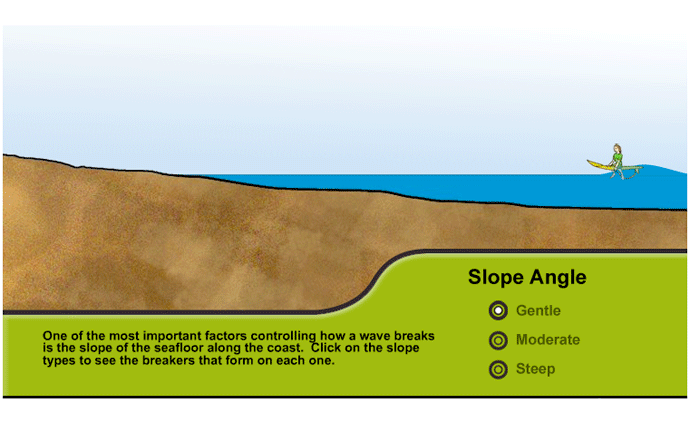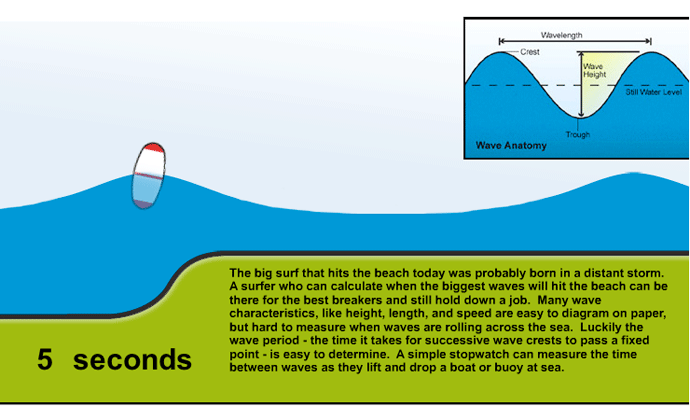Breaking Waves
Waves in the lonely stretches of the open sea are little noticed by anyone but the occasional sailor. But once they reach shore, they become much more interesting. When waves break, or become unstable and topple forward, they thrill beachgoers and dramatically reshape the coastline.
Few people study breakers with more passion than surfers. As you investigate wave behavior in this lesson, you’ll learn that catching the perfect wave is as much a science as an art.
Study each image below to learn how waves move and break.

Catch a Wave
- What happens to a wave as it moves into shallow water?
[Check Answer]
When the water depth decreases to one half of a wave’s wavelength, the wave starts to “feel the bottom”. That means that the deepest water molecules set into circular motion by the wave’s energy run into the seafloor. This forces the wave to grow upwards, so wave height increases. The base of the wave is slowed down by friction against the sea bottom, while the top of the wave rushes ahead, so the wave crest begins to lean more and more forward until it topples over, and breaks on the shore.
- Describe how the slope of the seafloor controls the way a wave breaks.
[Check Answer]
On a gentle slope, waves begin to feel the bottom far from the shore. The waves grow slowly taller and lean forward, and foam spills down their fronts as they run up onto the beach. On a moderate slope, the waves get closer to shore before they break. Because the water shallows more rapidly, wave energy is rapidly concentrated into a small area, so the waves grow very tall and the crests curl far forward of the troughs. On a steep slope, the waves don’t interact with the bottom until they are almost right at the shore, so they don’t have time to build-up, and instead just surge far up the beach without breaking.
- Which type of breaker - spilling, plunging, or surging – will cause the most coastal erosion? Explain.
[Check Answer]
A surging breaker will cause the most erosion because it slams into the beach at full speed. Spilling and plunging breakers slow down as they drag across the seafloor, so their energy is dissipated over a wider zone.
- Which type of breaker - spilling, plunging, or surging – will deposit sand onshore and expand beaches? Explain.
[Check Answer]
Waves can move sand when their energy is in contact with the bottom. Spilling breakers spend the most time and energy dragging across the seabed, so they should be able to push more sand onto the beach. Surging waves hardly interact with the bottom at all, so they will have little effect on offshore sand.

Measure a Wave
- What is the wave period in the above animation?
[Check Answer]
The wave period in the animation is about 6 seconds
- What is the relationship between wavelength and period? As wavelength increases, how is wave period affected?
[Check Answer]
The wavelength is the distance between successive waves, and the period is the time it takes for waves to cover that distance.
- The approximate speed of a wave train can be calculated from the average period of the waves in the train, using a simple formula: speed (in knots, which are nautical miles per hour) = 1.5 x period (in seconds). If NOAA reports that a gale 400 nautical miles offshore has kicked up high waves with a period of 12 seconds, when should you go to the beach?
[Check Answer]
The speed of the wave train is 1.5 x 12, or 18 miles an hour. Since the waves are coming from 400 nautical miles away, they should star hitting the beach in just over 22 hours (400/18 = 22.22).
- What will happen to the wave period as the wave train reaches shallow water?
[Check Answer]
If the time it takes for successive wave crests to pass a point is constant even as the waves slow down, then the crests must get closer together, which means the wavelength decreases. As waves approach the shore, they bunch up, and the crests break in rapid succession.
Related Links
Multimedia Discovery Missions: Lesson 9 - Ocean Waves

